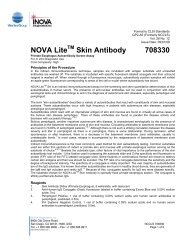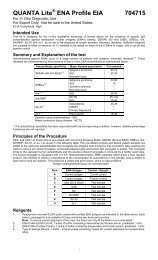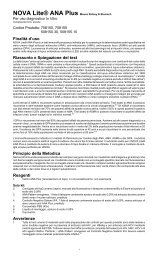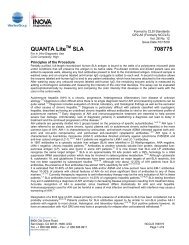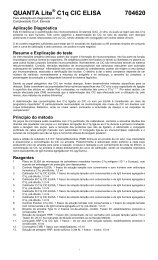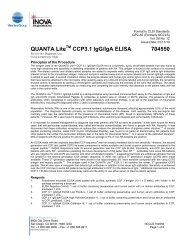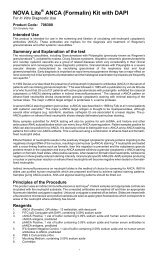INSTRUCTIONS FOR USE BINDAZYME Human ... - inova
INSTRUCTIONS FOR USE BINDAZYME Human ... - inova
INSTRUCTIONS FOR USE BINDAZYME Human ... - inova
You also want an ePaper? Increase the reach of your titles
YUMPU automatically turns print PDFs into web optimized ePapers that Google loves.
4.2 CAUTION<strong>INSTRUCTIONS</strong> <strong>FOR</strong> <strong>USE</strong>BINDAZYME <strong>Human</strong> Anticardiolipin IgG/IgMEIA Combi kitCodeAnalyte NameComplexity Cat.MK071This kit is for in-vitro diagnostic useFDA (USA) InformationIgG/IgM - MK071Anticardiolipin antibodiesHighProduct manufactured by:The Binding Site Ltd, PO Box 11712, Birmingham B14 4ZB UKwww.bindingsite.co.ukTelephone: +44 (0) 121 436 1000Fax: +44 (0) 121 430 7061e-mail: info@bindingsite.co.uk• These products should only be used by appropriately trained personnel.• Strict adherence to the protocol is recommended. Any deviation may affect assayperformance, and the results obtained. Pay attention to specific ‘Notes’ andwarnings throughout these Instructions for Use.• Reagents from different batch numbers of kits are NOT interchangeable. If largenumbers of tests are performed care should be taken to ensure that all reagentsare from the SAME batch. All strips used must be taken from the same foil pouch.Substitution of any component may lead to incorrect results.• To avoid reagent contamination, only use new or clean plastic / glassware. Neverreturn unused reagents to the bottles.• Do NOT leave reagent bottles uncapped; any resulting evaporation orcontamination will lead to inconsistent results.• TMB substrate must not be exposed to light or water.• Microbially contaminated, haemolysed or lipaemic serum and specimens containingparticulate matter should not be used.• Inaccurate sample dilution cannot be checked, as kit controls are ready to use. Theuse of calibrated pipettes and appropriate internal QC samples is recommended.• The use of automated assay systems, sample dilutors and other automatedequipment may lead to differences in results when compared to the manualprocedure. It is the responsibility of any laboratory to fully validate the system, andensure the results fall within the limits as defined in this insert and associated QCcertificate.• All equipment used must be calibrated and maintained according to themanufacturer’s instruction.4.3 STORAGE AND STABILITY• The kit should be stored at 2-8°C and should not be frozen. Inappropriate storagetemperatures will affect the results.• Wash buffer diluted into a clean container can be stored at room temperature(20-24°C) for a maximum of 4 weeks.• The expiry date of the kit is shown on the outer label.5 SAMPLE COLLECTION AND STORAGE1 INTENDED <strong>USE</strong>This assay is intended for the in-vitro measurement of IgG or IgM anticardiolipinantibodies in human serum, as an aid in the diagnosis of antiphospholipidsyndrome (APS).Sufficient materials are supplied to allow a maximum of 41 samples to be tested induplicate or 89 in single, with a calibration curve and a positive and negativecontrol.2 BACKGROUNDAnticardiolipin antibodies are found in a wide range of conditions either transiently,in some infectious diseases, or more persistently in autoimmune diseases such assystemic lupus erythematosus (SLE) and antiphospholipid syndrome (APS).Anticardiolipin antibodies have also been associated with a range of clinicalconditions 1-8 including; foetal loss, endocarditis, stroke, heart attack andautoimmune haemolytic anaemia (see references 9-12 for additional reading).3 PRINCIPLE OF THE ASSAYMicrowells are pre-coated with cardiolipin and cofactor. Calibrators, controls andpatient samples are added to the wells and autoantibodies recognising cardiolipinbind during the first incubation. After washing the wells to remove all unboundproteins, peroxidase labelled rabbit anti-human IgG or IgM antibody (γ or µ chainspecific) conjugate is added. The conjugate binds to the captured human antibodyand the excess unbound conjugate is removed by a further wash step. The boundconjugate is visualised with 3,3’,5,5’ tetramethylbenzidine (TMB) substrate whichgives a blue reaction product, the intensity of which is proportional to theconcentration of autoantibody in the sample. Phosphoric acid is added to eachwell to stop the reaction. This produces a yellow end point colour, which is read at450nm.4 PRECAUTIONS4.1 WARNING• All human sera supplied have been tested at donor level and found negative forHepatitis B surface antigens and antibodies to HIV 1 and 2 and Hepatitis C virus.However, these tests cannot guarantee the absence of infectious agents. Properhandling and disposal methods should be established and only personnel qualifiedin handling of potentially infectious materials should be permitted to use this kit.• Sodium azide may react with lead and copper plumbing to form explosive metalazides. On disposal of reagents flush with a large volume of water, to prevent azidebuild-up.• The buffers and serum supplied in this kit contain various enzyme inhibitors aslisted below. These should be handled with care.INHIBITORKathonSodium AzideProclin 300BromonitrodioxaneMethylisothiazoneE-amino-n-caproic acid (EACA)BenzamidineCONCENTRATION0.05%0.099%0.045%0.002%0.002%0.1%0.01%Proclin is a trademark of Rohm and Haas Corp. Philadelphia PA• Kathon is an irritant and may cause sensitisation by skin contact.• The stop solution contains 3M phosphoric acid which is an irritant. Avoid contactwith skin and eyes.• Reagent spills should be cleaned up appropriately, observing local andenvironmental regulations.• Blood samples should be collected by venepuncture allowed to clot naturally andthe serum separated.• The serum may be stored at 2-8°C for up to 7 days prior to assay 13 , or forprolonged storage, aliquoted and stored at -20°C or below.• Repeated thawing and freezing should be avoided.• Serum samples should not be heat-inactivated, as this may give false positiveresults.6 MATERIALS6.1 MATERIALS SUPPLIED• Instruction Leaflet: Giving full assay details.• QC Certificate: Indicating the expected performance of the batch.• Cardiolipin Coated Wells: 12 break-apart 8 well strips coated with bovinecardiolipin antigen. The plate is packaged in a re-sealable foil bag containingtwo desiccant pouches.• Type II Sample Diluent: 2 bottles containing 50mL of buffer for sample dilution.Coloured yellow, ready to use.• Type II Wash Buffer (20x Concentrate): 1 bottle containing 50mL of a 20-foldconcentrated buffer for washing the wells.• Cardiolipin IgG Calibrators: 5 bottles each containing 1.2mL of diluted humanserum, with the following concentrations of anticardiolipin autoantibody: 100, 50,25, 12.5, 6.25 GPL U/mL. Ready to use.The calibrator set is calibrated against the Louisville APL reference preparation asdetailed in section 8.6 of this insert.• Cardiolipin IgM Calibrators: 5 bottles each containing 1.2mL of diluted humanserum, with the following concentrations of anticardiolipin autoantibody: 100, 50,25, 12.5, 6.25 MPL U/mL. Ready to use.The calibrator set is calibrated against the Louisville APL reference preparation asdetailed in section 8.6 of this insert.• Cardiolipin IgG Positive Control: 1 bottle containing 1.2mL of diluted humanserum. The expected value is given on the QC certificate. Ready to use.• Cardiolipin IgM Positive Control: 1 bottle containing 1.2mL of diluted humanserum. The expected value is given on the QC certificate. Ready to use.• Cardiolipin Negative Control: 1 bottle containing 1.2mL of diluted humanserum. The expected value is given on the QC certificate. Ready to use.• Cardiolipin IgG Conjugate: 1 bottle containing 12mL of purified peroxidaselabelled antibody. Coloured red, ready to use.• Cardiolipin IgM Conjugate: 1 bottle containing 12mL of purified peroxidaselabelled antibody. Coloured blue. Ready to use.• TMB Substrate: 1 bottle containing 14mL TMB substrate. Ready to use.• Stop Solution: 1 bottle containing 14mL of 3M phosphoric acid. Ready to use.6.2 ADDITIONAL MATERIALS AND EQUIPMENT – not supplied• Automatic microplate plate washer: This is recommended, however, platewashing can be performed manually.• Plate reader: capable of measuring optical densities at 450nm referenced on air.• Distilled or deionised water: This should be of the highest quality available.• Calibrated micropipettes: for dispensing 1000, 100 & 10µL.• Multichannel pipette: Recommended for dispensing 100µL volumes ofconjugate, substrate and stop solution.• Glass/plastic tubes: for sample dilution.Insert Codes: E071, Version: 11 March 2008, Page 1 of 10
7 ASSAY METHOD7.1 PRE-ASSAY STEPS1. Bring the kit to room temperature• The kit is designed for room temperature operation (20-24°C).• Remove the kit from storage and stand at room temperature for approximately 60minutes. Wells must not be removed from the foil bag until they have reachedroom temperature.Note: The kits may be maintained at room temperature for up to 1 week.2. Kit componentsGently mix each kit component before use.3. Wash buffer dilutionAdd 50mL of the wash buffer concentrate to 950mL of distilled water (1 in 20dilution) into a clean container and mix. Smaller volumes can be diluted asappropriate.Note: Diluted wash buffer can be stored at room temperature for up to 4 weeks,therefore only dilute the appropriate amount.4. Sample dilutionDilute 10µL of each sample with 1000µL of sample diluent (1:100) and mix well.Note: Diluted sample must be used within 8 hours.5. Strip and frame handlingPlace the required number of wells in the strip holder. Position from well A1, fillingcolumns from left to right across the plate. When handling the plate, squeeze thelong edges of the frame to prevent the wells falling out.Note: Return unused wells to the foil bag immediately with the two desiccantpouches and re-seal tightly to minimise exposure to moisture.Take care not to puncture or tear the foil bag, see below.WARNING: Exposure of wells to moisture or contamination by dust or otherparticulate matter will result in antigen degradation, leading to poor assayprecision and potentially false results.7.2 ASSAY METHODMaintain the same dispensing sequence throughout the assay.1. Sample additionDispense 100µL of each calibrator, control and diluted (1:100) sample into theappropriate wells of the plate provided.Note: Samples should be added as quickly as possible to the plate to minimiseassay drift, and the timer started after the addition of the last sample.Incubate at room temperature for 30 minutes.2. WashingThe washing procedure is critical and requires special attention. An improperlywashed plate will give inaccurate results, with poor precision and highbackgrounds.After incubation remove the plate and wash wells 3 times with 250-350µL washbuffer per well. Wash the plate either by using an automatic plate washer ormanually as indicated below. After the final automated wash, invert the plate andtap the wells dry on absorbent paper.Plates can be washed manually as follows:a. Flick out the contents of the plate into a sink.b. Tap the wells dry on absorbent paper.c. Fill each well with 250-350µL of wash buffer using a multichannelpipette.d. Gently shake the plate on a flat surface.e. Repeat a-d twice.f. Repeat a and b.3. Conjugate additionDispense 100µL of conjugate into each well, blot the top of the wells with a tissueto remove any splashes.Note: To avoid contamination, never return excess conjugate to the reagentbottle.Incubate at room temperature for 30 minutes.4. WashingRepeat step 2.5. Substrate (TMB) additionDispense 100µL of TMB substrate into each well, blot the top of the wells with atissue to remove any splashes.Note: To avoid contamination never return excess TMB to the reagent bottle.Incubate at room temperature in the dark for 30 minutes.6. StoppingDispense 100 µL of stop solution into each well. This causes a change in colourfrom blue to yellow.7. Optical density measurementRead the optical density (OD) of each well at 450nm on a microplate reader,within 30 minutes of stopping the reaction.8 RESULTS AND QUALITY CONTROL1. Quality controlIn order for an assay to be valid, all the following criteria must be met:• Calibrators and the positive and negative controls must be included in each run.• The values obtained for all the controls should be in the ranges specified on theQC Certificate.• The curve shape should be similar to the calibration curve, shown on the QCCertificate.If the above criteria are not met, the assay is invalid and the test should berepeated.2. Calculate mean optical densities (For assays run in duplicate only)For each calibrator, control and sample calculate the mean OD of the duplicatereadings. The percentage coefficient of variation (%C.V.) for each duplicate ODshould be less than 15%.3. Plot calibration curveThe calibration curve can be plotted either automatically or manually as follows byplotting the anticardiolipin autoantibody concentration on the log scale against theOD on the linear scale for each calibrator:• Automatic - use appropriately validated software, and the curve fit that best fits thedata.• Manual - using log/linear graph paper, draw a smooth curve through the points(not a straight line or point to point).4. Treatment of anomalous pointsIf any one point does not lie on the curve, it can be removed. If the absence of thispoint means that the curve has a shape dissimilar to that of the sample calibrationcurve, or more than one point appears to be anomalous, then the assay should berepeated.5. Calculation of autoantibody levels in controls and samplesRead the level of the anticardiolipin autoantibody in the controls and dilutedsamples directly from the calibration curve. The control values should fall withinthe range given on the QC Certificate.Note: The calibrator values have been adjusted by a factor of 100 to account for a1:100 sample dilution. No further correction is required.6. Assay calibrationThe assays are calibrated against the Louisville reference LAPL-GM-200. OneGPL unit is defined as the cardiolipin binding activity of 1µg/mL of an affinitypurified IgG anticardiolipin preparation from a standard serum 14 . One MPL unit isdefined as the cardiolipin binding activity of 1µg/mL of an affinity purified IgManticardiolipin preparation from a standard serum 14 .The Louisville reference centre recommends the following positive discriminationcriteria according to the recommendation of the 2 nd International AnticardiolipinWorkshop 14 .Anticardiolipin IgG Anticardiolipin IgMCriteria Range (GPLU/mL) Range (MPL U/mL)High positive >80 >80Medium positive ≥20-80 ≥20-80Low positive ≥10,
Number of SamplesBased on a negative cut-off of 10 MPL U/mL, four of the samples were consideredto be positive with values of 19.8, 19.5, 18.2 and 10.4 MPL U/mL.Number of Samples454035302520151050605040302010These normal ranges are provided as guides only. It is recommended that eachlaboratory determine its own normal range.9.3 SPECIFICITY, SENSITIVITY, AGREEMENTThe relative specificity, sensitivity and agreement has been determined against analternative anticardiolipin EIA using 77 test samples.EIABINDAZYMEIgG Anticardiolipin EIAAlternative EIA+ -+ 40 3- 1 33Relative sensitivity 97.6%Relative specificity 91.7%Relative agreement 91.7%EIABINDAZYMEIgM Anticardiolipin EIAAlternative EIA+ -+ 26 0- 8 43Relative sensitivity 76.5%Relative specificity 100%Relative agreement 89.6%9.4 ANALYTICAL SENSITIVITYSensitivity was determined as the mean concentration + 2 SD given by 20determinations of the sample diluent.AssayAnticardiolipin IgGAnticardiolipin IgM9.5 MEASURING RANGESensitivity1.0 GPL U/mL0.6 MPL U/mLThe measuring range of the assays is 6.25 – 100 GPL U/mL and 6.25 – 100 MPLU/mL9.6 INTERFERING SUBSTANCESSerum samples containing elevated levels of lipid, haemoglobin, bilirubin andimmunoglobulin, were tested to assess their effects in this assay. No interferencewas seen.Note: Samples from patients with paraproteins may give false positive IgM results.However it has been documented 17 that some paraproteins display specific antiphospholipidactivity.10 EXPECTED VALUES00-2 2.1-4 4.1-6 6.1-8 8.1-11 >11IgG anti-cardiolipin GPL U/mL0-2 2.1-4 4.1-6 6.1-8 8.1-10 >10IgM anticardiolipin (MPL U/mL)
4.2 VORSICHTSMAßNAHMENARBEITSANLEITUNGBINDAZYME EIA Kombi-kitAnticardiolipin IgG/IgM (<strong>Human</strong>)Bestell-Nr.: MK071Nur zur in-vitro DiagnostikHergestellt von:The Binding Site Ltd, PO Box 11712, Birmingham B14 4ZB, UK.www.bindingsite.co.ukVertrieb in Deutschland und Österreich durch:The Binding Site GmbH, Robert-Bosch-Straße 2AD-68723 Schwetzingen, DeutschlandTelefon: +49 (0) 6202 92 62 0Fax: +49 (0) 6202 92 62 222e-mail: office@bindingsite.de1 VERWENDUNGSZWECKDieser Kit dient zur in-vitro Bestimmung von IgG-Antikörpern oder IgM-Antikörperngegen Cardiolipin in humanem Serum, zur Unterstützung der Diagnose desAntiphospholipid Syndroms (APS).Der Kit enthält ausreichend Material, um maximal 41 Proben in Doppelbestimmungoder 89 Proben in Einzelbestimmung zu messen, sowie eineKalibrationskurve und je eine Positiv- und Negativkontrolle.2 EINFÜHRUNGAnticardiolipin-Antikörper treten bei einigen Infektionserkrankungenvorübergehend (transient), bei einigen Autoimmunerkrankungen, wie z. B.Systemischem Lupus Erythematodes (SLE) und Antiphospholipid Syndrom (APS)persistierend auf. Anticardiolipin-Antikörper werden weiterhin in Zusammenhangmit einer Reihe von Erkrankungen assoziiert 1-8 , inkl. habituellen Aborten,Endokarditis, Schlaganfall, Herzanfall und autoimmunhämolytischer Anämie.(Siehe Ref. 9-12 für weiterführende Informationen.)3 TESTPRINZIPDie Wells (Vertiefungen) der Mikrotiterplatten sind mit Cardiolipin und Cofaktorbeschichtet. Die Kalibratoren, Kontrollen und zu testende Proben werden in denWells inkubiert, so dass die Anticardiolipin Autoantikörper während der erstenInkubation an das immobilisierte Antigen binden können. Nach dem Waschen derWells - zum Entfernen des ungebundenen Proteins - gibt man das, mit Peroxidasemarkierte Kaninchen anti-human-IgG- oder IgM-Konjugat (spezifisch für γ- oder µ-Kette) hinzu. Nach einer weiteren Inkubation und einem weiteren Waschvorgang -um das ungebundene Konjugat zu entfernen - wird das gebundene Konjugat mitHilfe von 3,3',5,5' - Tetramethylbenzidin (TMB) sichtbar gemacht. TMB ergibt einblaues Reaktionsprodukt, dessen Intensität proportional zur Autoantikörper-Konzentration der Probe ist. Phosphorsäure wird in jedes Well pipettiert um dieReaktion zu stoppen. Das gelbe Reaktionsprodukt wird bei 450nm gemessen.4 WARNUNGEN UND VORSICHTSMAßNAHMEN4.1 WARNUNGEN• Das Ausgangsmaterial zur Erstellung der Kalibratoren und Kontrollen stammt ausmenschlichem Blut. Jede Einzelspende wurde bezüglich Antikörpern gegen<strong>Human</strong>-Immunschwäche-Virus (HIV 1 & 2), Hepatitis-C-Virus und Hepatitis-B-Oberflächenantigen (HBsAG) untersucht und als negativ befunden. Es gibt aberzur Zeit keine absolut sicheren Testmethoden zum Auschluss vonInfektionsträgern. Deshalb sollten die Reagenzien als potentiell infektiösbehandelt werden. Umgangs- und Entsorgungsmethoden sollten denen fürpotentiell infektiöses Material entsprechen und der Test nur von entsprechendgeschultem Personal durchgeführt werden.• Natriumazid kann mit Blei- oder Kupferrohren explosive Metallazide bilden. Nachder Entsorgung mit ausreichender Menge Wasser nachspülen umAzidablagerungen zu vermeiden.• Alle Puffer und Seren im Kit enthalten die unten aufgelisteten Enzym-Inhibitorenals Konservierungsmittel. Diese sollten mit der entsprechenden Vorsichtbehandelt werden.INHIBITORKathonNatriumazidProclin 300BromonitrodioxanMethylisothiazonE-Amino-n-Capronsäure (EACA)BenzamidinKONZENTRATION0,05%0,099%0,045%0,002%0,002%0,1%0,01%Proclin ist ein eingetragenes Warenzeichen der Rohm and Haas Corp. Philadelphia PA• Kathon wirkt reizend und kann bei Hautkontakt zu einer Sensibilisierung führen.• Die Stopp-Lösung enthält 3M Phosphorsäure. Sie ist reizend, deshalb Kontakt mitHaut und Augen vermeiden.• Verschüttete Reagenzien entsprechend beseitigen, dabei sind ökologische undgesetzliche Bestimmungen zu beachten.• Dieser Test sollte nur von entsprechend geschultem Laborpersonal durchgeführtwerden.• Testdurchführung strikt nach Arbeitsanleitung. Jegliche Abweichung kann dieTestqualität und Ergebnisse beeinflussen. Beachten Sie die spezifischen‚Hinweise‘ und Warnungen in dieser Arbeitsanleitung.• Reagenzien unterschiedlicher Chargen dürfen NICHT untereinander gemischtoder gemeinsam verwendet werden. Bei großem Testdurchsatz muss daraufgeachtet werden, dass alle Reagenzien der GLEICHEN Charge entstammen. AlleMikrotiterstreifen müssen aus demselben Folienbeutel entnommen werden. DerAustausch einer Testkomponente kann inkorrekte Ergebnisse zur Folge haben.• Zur Vermeidung von Kontaminationen der Reagenzien immer saubere PlastikoderGlasgefäße verwenden. Niemals unbenutztes Reagenz in die Flaschenzurückgeben.• Reagenzienflaschen nicht für längere Zeit offen stehenlassen. Die darausresultierende Verdunstung oder Verunreinigung führt zu widersprüchlichenErgebnissen.• TMB darf weder mit Licht noch mit Wasser in Berührung kommen!• Die Verwendung von mikrobiell oder mit Partikeln verunreinigter, hämolytischeroder lipämischer Seren vermeiden.• Falsche Probenverdünnungen können nicht erkannt werden, da die Kit-Kontrollengebrauchsfertig sind. Es wird empfohlen kalibrierte Pipetten und geeignete interneKontrollen zu verwenden.• Die Verwendung von ELISA-Automaten, Pipettierautomaten oder anderenautomatisierten Geräten kann im Vergleich zur manuellen Testdurchführung zuabweichenden Ergebnissen führen. Jedes Labor muss das System vollständigvalidieren und sicherstellen, dass die Ergebnisse innerhalb des in dieserArbeitsanleitung und dem beigefügten QC-Zertifikat Spezifikationen liegen.• Die verwendeten Geräte und Pipetten müssen gemäß der Herstellerangabenkalibriert und gewartet werden.4.3 LAGERUNG UND STABILITÄT• Den Kit bei 2-8°C lagern, nicht einfrieren. Lagerung bei falscher Temperaturbeeinflusst die Ergebnisse.• Der verdünnte Waschpuffer ist in einem sauberen Gefäß bei Raumtemperatur(20-24°C) bis maximal 4 Wochen haltbar.• Die Haltbarkeit des Kits wird auf dem Außenetikett angegeben.5 PROBENENTNAHME UND -VORBEREITUNG• Blutproben über Venenpunktur sammeln und auf natürliche Weise gerinnenlassen. Serum vom Gerinnsel trennen.• Die Seren können bei 2-8°C bis zu 7 Tage vor dem Test gelagert werden 13 . Füreine längere Lagerung empfiehlt es sich, die Seren aliquotiert bei mindestens-20°C einzufrieren.• Wiederholtes Einfrieren und Auftauen der Proben vermeiden.• Serumproben nicht hitzeinaktivieren, dies kann zu falsch-positiven Ergebnissenführen.6 MATERIALIEN6.1 GELIEFERTE MATERIALIEN• Arbeitsanleitung: mit genauen Angaben zur Testdurchführung.• QC-Zertifikat: mit Angaben zu Kontroll-Sollwerten und ideale Kalibrationskurve.• Cardiolipin Coated Wells (Cardiolipin beschichtete Mikrotiterstreifen): 12 Mikrotiterstreifenmit 8 vereinzelbaren Wells, die mit Rinder Cardiolipin-Antigenbeschichtet sind. Die Streifen sind in einem wiederverschließbaren Folienbeutel,der zwei Beutel Trockenmittel enthält, verpackt.• Type II Sample Diluent (Probenverdünnungspuffer): 2 Flaschen mit je 50mLgebrauchsfertigem Puffer zur Probenverdünnung. Farbcodierung: gelb.• Type II Wash Buffer (20x Concentrate) (Waschpuffer): 1 Flasche mit 50mLeines 20-fach konzentrierten Puffers zum Waschen der Wells.• Cardiolipin IgG Calibrator (Anticardiolipin IgG Kalibratoren): 5 Flaschen mit je1,2mL gebrauchsfertig verdünntem <strong>Human</strong>serum der folgende Konzentrationenan Anticardiolipin-Autoantikörper enthält: 100; 50; 25; 12,5; 6,25 GPL U/mL.Der Kalibrator-Set ist gegen die Louisville APL Referenzpräparation kalibriert.(Siehe Abschnitt 8.6)• Cardiolipin IgM Calibrator (Anticardiolipin IgM Kalibratoren): 5 Flaschen mit je1,2mL gebrauchsfertig verdünntem <strong>Human</strong>serum der folgende Konzentrationenan Anticardiolipin-Autoantikörper enthält: 100; 50; 25; 12,5; 6,25 MPL/U/mL.Der Kalibrator-Set ist gegen die Louisville APL Referenzpräparation kalibriert.(Siehe Abschnitt 8.6)• Cardiolipin IgG Positive Control (Anticardiolipin-IgG-Positivkontrolle): 1 Flaschemit 1,2mL verdünntem <strong>Human</strong>serum. Der Sollwert ist auf dem QC-Zertifikatangegeben. Gebrauchsfertig.• Cardiolipin IgM Positive Control (Anticardiolipin-IgM-Positivkontrolle): 1 Flaschemit 1,2mL verdünntem <strong>Human</strong>serum. Der Sollwert ist auf dem QC-Zertifikatangegeben. Gebrauchsfertig.• Cardiolipin Negative Control (Anticardiolipin-Negativkontrolle): 1 Flasche mit1,2mL verdünntem <strong>Human</strong>serum. Der Sollwert ist auf dem QC-Zertifikatangegeben. Gebrauchsfertig.• Cardiolipin IgG Conjugate (IgG Konjugat): 1 Flasche mit 12mL gereinigtem, Peroxidase-markiertemAntikörper, Farbcodierung: rot. Das Konjugat istgebrauchsfertig.• Cardiolipin IgM Conjugate (IgM Konjugat): 1 Flasche mit 12mL gereinigtem, Peroxidase-markiertemAntikörper. Farbcodierung: blau. Das Konjugat istgebrauchsfertig.• TMB Substrate (TMB-Substrat): 1 Flasche mit 14mL TMB-Lösung.Gebrauchsfertig.• Stop Solution (Stopp-Lösung): 1 Flasche mit 14mL 3M Phosphorsäure. Gebrauchsfertig.Insert Codes: E071, Version: 11 March 2008, Page 4 of 10
6.2 BENÖTIGTE, NICHT IM KIT ENTHALTENE MATERIALIEN• Automatisches Mikrotiterplatten-Waschgerät: ist empfehlenswert, aber diePlatten können auch manuell gewaschen werden.• Mikrotiterplatten-Reader: Messung der optischen Dichte in den Wells bei450nm. Referenzmessung erfolgt gegen Luft.• Destilliertes oder deionisiertes Wasser: Es sollte von höchster Qualität und freivon Metallionen sein.• Kalibrierte Micropipetten: Zum Pipettieren von1000, 100 & 10µL.• Mehrkanal-Pipette: Zum Pipettieren von 100µL Volumina von Konjugat, TMB-Substrat und Stopp-Lösung.• Glas- oder Plastikgefäße: Zur Probenverdünnung.7 TESTDURCHFUHRUNG7.1 TESTVORBEREITUNG1. Kit auf Raumtemperatur erwärmenDie optimale Temperatur für die Testdurchführung liegt bei 20-24°C. Den Kit nachEntnahme aus dem Kühlschrank ca. 60 Minuten auf Raumtemperatur erwärmenlassen. Die Wells nicht vor Erreichen der Raumtemperatur aus dem Folienbeutelnehmen.Hinweis: Der Kit kann bis zu 1 Woche bei Raumtemperatur gelagert werden.2. Kit-KomponentenJede Kit-Komponente vor Gebrauch kurz schütteln.3. Waschpuffer verdünnenDazu 50mL Waschpuffer-Konzentrat und 950mL destilliertes Wasser (1/20Verdünnung) in ein sauberes Gefäß geben und mischen. Es können auchentsprechend kleinere Volumina verdünnt werden.Hinweis: Der verdünnte Puffer ist bei Raumtemperatur bis zu 4 Wochen haltbar;deshalb nur die benötigte Menge verdünnen.3. Verdünnung der Proben10µL jeder Probe mit 1000µL Proben-Verdünnungspuffer verdünnen (1:100) undgut mischen.Hinweis: Die verdünnten Proben müssen innerhalb von 8 Stunden verwendetwerden.4. Umgang mit Streifen und RahmenDie benötigte Anzahl Wells aus dem Folienbeutel entnehmen und in den Rahmensetzen. Dabei von Position A1 ausgehend die Spalten von links nach rechtsauffüllen. Achten Sie darauf, die langen Seiten des Rahmenszusammenzudrücken, damit die Wells nicht herausfallen können.Hinweis: Um die Kontaktzeit mit der Luftfeuchtigkeit zu minimieren die nichtverwendeten Wells sofort in den wiederverschließbaren Folienbeutel mit demTrockenmittel geben und gut verschließen. Darauf achten, dass der Folienbeutelnicht beschädigt wird.ACHTUNG: Kontakt mit Feuchtigkeit oder Verunreinigung durch Staub oderanderen Partikeln kann einen Antigen-Abbau verursachen. Daraus resultierteine schlechte Präzision und potentiell falsche Ergebnisse.7.2 TESTDURCHFÜHRUNGAlle Reagenzien in der gleichen Reihenfolge pipettieren.1. Pipettieren der Kontrollen und Proben und Inkubation100µL von jedem Kalibrator, jeder Kontrolle und jeder verdünnten (1:100) Probe indas dafür laut Plattenschema vorgesehene Well pipettieren.Hinweis: Die Proben müssen so schnell wie möglich pipettiert werden; dieInkubationszeit läuft ab Zugabe der letzten Probe.30 Minuten bei Raumtemperatur inkubieren.2. Waschen der PlatteSorgfältiges Waschen der Wells ist wichtig für eine hohe Präzision und genaueTestergebnisse. Bei nicht korrekt gewaschenen Wells können ungenaueErgebnisse mit schlechter Präzission und hohem Hintergrund auftreten.Nach der Inkubation die Wells dreimal mit 250-350µL Waschpuffer waschen. DasWaschen kann mit einem automatischen Platten-Waschgerät oder manuellerfolgen. Nach dem letzten Waschschritt die Wells durch leichtes Klopfen auf eineabsorbierende Unterlage (z.B. Papiertücher) trocknen.Manuelles Waschen:a. Den Inhalt der Wells in den Ausguss schütten, dabei die langen Seitendes Rahmens zusammendrücken.b. Die Wells auf einer absorbierenden Unterlage (z. B. Papiertücher) leichtausklopfen.c. 250-350µL Waschpuffer in der Arbeitskonzentration in die Wellspipettieren.d. Die Mikrotiterplatte auf einer flachen Unterlage stehend leicht schütteln.e. Zweimaliges Wiederholen der Schritte a bis d.f. Die Wells wie unter a und b entleeren.3. Pipettieren des Konjugats100µL Konjugat in jedes Well pipettieren. Die Ränder der Wells mit Filterpapierabtrocknen um Spritzer zu entfernen.Hinweis: Um Verunreinigungen zu vermeiden, niemals überschüssiges Konjugatin die Konjugat-Flasche zurückgeben.30 Minuten bei Raumtemperatur inkubieren.4. Waschen der PlatteSiehe Abschnitt 2.5. Pipettieren von Substrat (TMB)Nach dem Waschen 100µL TMB in jedes Well pipettieren. Die Ränder der Wellsmit Filterpapier abtrocknen um Spritzer zu entfernen.Hinweis: Um Verunreinigungen zu vermeiden, niemals überschüssiges TMB indie TMB-Flasche zurückgeben.30 Minuten bei Raumtemperatur im Dunkeln inkubieren.6. Reaktionsende100µL Stopp-Lösung in jedes Well pipettieren. Die Farbe schlägt von blau nachgelb um.7. FarbmessungDie optische Dichte (OD) bei 450nm in jedem Well mit einem Mikrotiterplatten-Reader innerhalb von 30 Minuten nach Reaktionsende bestimmen.8 ERGEBNISSE UND QUALITATSKONTROLLE1. QualitätskontrolleNur, wenn alle nachfolgend aufgeführten Kriterien erfüllt sind, ist der Test gültig.Ist dies nicht der Fall, ist der Test ungültig und muss wiederholt werden.• Kalibratoren und Kontrollen müssen bei jedem Testansatz mitgeführt werden.• Das Ergebnis der Kontrollen muss in dem angegebenen Wertebereich (siehe QC-Zertifikat) liegen.• Die berechnete Kalibrationskurve sollte der auf dem QC-Zertifikat abgebildetenKalibrationskurve ähnlich sein.2. Berechnung der mittleren optischen Dichte (nur bei Doppelbestimmungen)Für jeden Kalibrator und jede Kontrolle und Probe die mittlere optischen Dichte(OD) der Doppelbestimmungen berechnen. Der Variationskoeffizient (%VK) derDoppelbestimmungen sollte jeweils unter 15% liegen.3. Erstellen der KalibrationskurveDie Kalibrationskurve kann entweder automatisch oder manuell erstellt werden.Dazu wird die Anticardiolipin-Autoantikörper-Konzentration auf derlogarithmischen Skala gegen die OD-Werte auf der linearen Skala für jedenKalibrator aufgetragen.• Automatisch: Geeignete, validierte Software verwenden. Kalkulationsmodusverwenden, der am besten zu den Daten passt.• Manuell: Halblogarithmisches Millimeterpapier verwenden, eine Ausgleichskurvedurch die Punkte legen (keine Gerade oder Punkt-zu-Punkt-Verbindung).4. Umgang mit abweichenden KalibrationspunktenLiegt ein Messpunkt nicht auf der Kalibrationskurve, so kann er weggelassenwerden. Der Test sollte wiederholt werden, wenn die daraus resultierendeKalibrationskurve deutlich von der im QC-Zertifikat angegebenen Kurvenformabweicht oder, wenn mehrere Kalibrationspunkte zu starke Abweichungen aufweisen.5. Berechnung der Autoantikörper-Konzentrationen in den Kontrollen undProbenDie Anticardiolipin-Autoantikörper-Konzentrationen der Kontrollen und Probendirekt aus der Kalibrationskurve ablesen. Die Kontrollwerte müssen in den im QC-Zertifikat angegebenen Bereich fallen.Hinweis: Die Standard-Probenverdünnung von 1:100 ist in der Kalibrationskurvebereits berücksichtigt. Es sind keine weiteren Korrekturen nötig.6. Kalibration des TestsDer Testkit ist gegen die Louisville-Referenzpräparation LAPL-GM-200 kalibriert.Eine GPL-Einheit (Unit) ist folgendermaßen definiert: 1 GPL-Unit entspricht derCardiolipin-Bindungsaktivität von 1µg/mL einer affinitätsgereinigten IgG-AnticardiolipinPräparation aus einem Standardserum 14 . 1 MPL-Unit entspricht derCardiolipin-Bindungsaktivität von 1µg/mL einer affinitätsgereinigten IgM-AnticardiolipinPräparation aus einem Standardserum 14 .Das Louisville Referenzzentrum empfiehlt die folgenden positiven Diskriminierungskriteriengemäß der Empfehlung des 2 nd International AnticardiolipinWorkshop 14 .Anticardiolipin IgG Anticardiolipin IgMKriterien Bereich (GPLU/mL) Bereich (MPLU/mL)Stark Positiv >80 >80Mittel Positiv ≥20-80 ≥20-80Schwach Positiv ≥10,
INTER-ASSAY PRÄZISIONAnticardiolipin IgGn=3 Konzentration (GPL U/mL) %VKProbe 1 82,5 2,7Probe 2 7,8 3,7Anticardiolipin IgMn=3 Konzentration (MPL U/mL) %VKProbe 1 89,5 2,3Probe 2 7,6 5,09.2 NORMALBEREICHIn Seren von 102 normalen Blutspendern wurde die Anticardiolipin-Autoantikörperkonzentrationermittelt. Die Ergebnisse sind in der nachfolgenden Abbildungzusammengefasst. Mit dem negativen Cut-Off von 11 GPL U/mL wurde keineProbe als positiv eingestuft.Anzahl der ProbenMit dem negativen Cut-Off von 10 MPL U/mL wurden 4 Proben (Messwerte: 19,8;19,5; 18,2 und 10,4 MPL U/mL) als positiv eingestuft.Anzahl der Proben45403530252015105060504030201000-2 2.1-4 4.1-6 6.1-8 8.1-11 >11Dieser Normalbereich dient nur zur Orientierung. Es wird empfohlen, dass jedesLabor einen eigenen Normalbereich ermittelt.9.3 SPEZIFITÄT, SENSITIVITÄT UND ÜBEREINSTIMMUNGDie relative Spezifität, Sensitivität und Übereinstimmung wurden durch Vergleichvon 77 Proben mit einem anderen kommerziellen Anticardiolipin-EIA-Kit ermittelt.EIABINDAZYMEIgG Anticardiolipin EIAAlternativer EIA+ -+ 40 3- 1 33Relative Sensitivität 97,6%Relative Spezifität 91,7%Relative Übereinstimmung 91,7%EIABINDAZYMEIgM Anticardiolipin EIAIgG-Anticardiolipin GPL U/mL0-2 2.1-4 4.1-6 6.1-8 8.1-10 >10IgM Anticardiolipin MPL U/mLAlternativer EIA+ -+ 26 0- 8 43Relative Sensitivität 76,5%Relative Spezifität 100%Relative Übereinstimmung 89,6%9.5 MESSBEREICHAssayAnticardiolipin IgGAnticardiolipin IgMAnalytische Sensitivität1,0 GPL U/mL0,6 MPL U/mLDer Messbereich des Kits liegt zwischen 6,25-100 GPL U/mL und 6,25-100 MPLU/mL.9.6 INTERFERIERENDE SUBSTANZENSeren, die eine erhöhte Konzentration an Lipiden, Haemoglobin, Bilirubin undImmunglobulinen enthalten, wurden getestet um den Einfluss dieser Substanzenauf den Test zu überprüfen. Es wurden keinerlei Beeinflussungen durch dieseSubstanzen festgestellt.Hinweis: Proben von Patienten mit Multiplem Myelom können falsch-positive IgMErgebnisse erzeugen. Es wurde aber beschrieben und dokumentiert 17 , dasseinige Paraproteine eine spezifische Anti-Phospholipid-Aktivität aufweisen.10 ZU ERWARTENDE WERTEDer normale Cut-Off wurde anhand von 102 Seren von normalen Blutspendernermittelt und liegt bei 11 GPL U/mL oder bez. 10 MPL U/mL. Mittlerweile ist dieBeobachtung, dass häufig niedrige Anticardiolipin-Konzentrationen von
2. Calcul des moyennes des densités optiques (pour les tests réalisés en doubleseulement)Pour chaque calibrateur, contrôle et échantillon, calculer la DO moyenne desduplicats. Le pourcentage du coefficient de variation (%CV) pour chaque duplicatde DO doit être inférieur à 15%.3. Courbe de calibrationLa courbe de calibration peut être tracée automatiquement ou manuellement enindiquant en abscisses la concentration en anticorps anti-phosphatidylsérine surune échelle logarithmique et en ordonnées la DO pour chaque calibrateur sur unelinéaire.Automatique - utiliser le logiciel approprié avec une courbe la plus proche possibledes données.• Manuel - utiliser un papier linéaire/logarithmique et tracer une courbe passant partous les points (pas une droite ni du point à point).4. Traitement des points anormauxSi seul un point n’est pas sur la courbe, il peut être supprimé. Si en l’absence dece point, la courbe a une forme différente de celle du certificat de contrôle dequalité ou si plusieurs points ne sont pas sur la courbe, le test doit être répété.5. Calcul des concentrations d’autoanticorps dans les contrôles et leséchantillonsDéduire la concentration en autoanticorps anticardiolipines des contrôles et deséchantillons dilués à partir de la courbe de calibration. Les valeurs des contrôlesdoivent être comprises dans les limites indiquées sur le certificat de contrôlequalité.Note : Les valeurs des calibrateurs ont été ajustées d’un facteur 100 pour tenircompte de la dilution de l’échantillon au 1:100. Par conséquent, aucune correctionn’est requise.6. Calibration du testLes tests sont calibrés par rapport à la référence de Louisville LAPL-GM-200. Uneunité GPL est définie comme l’activité de liaison des cardiolipines d’unepréparation d’IgG anti-cardiolipines purifiée par affinité de 1µg/mL obtenue à partird’un sérum standard 14 . Une unité MPL est définie comme l’activité de liaison descardiolipines d’une préparation d’IgM anti-cardiolipines purifiée par affinité de1µg/mL obtenue à partir d’un sérum standard 14 .Le centre de référence de Louisville recommande les seuils de positivité suivantsselon les recommandations du ‘2 nd International Anticardiolipin Workshop’ 14 :Anticardiolipin IgG Anticardiolipin IgMCritères U GPL/mL U MPL/mLPositivité forte >80 >80Positivité moyenne ≥20-80 ≥20-80Positivité faible ≥10, 10Anti-cardiolipines IgM U MPL/mLLes sérums contenant des taux élevés de lipides, d’hémoglobine, de bilirubine oud’immunoglobulines ont été testés pour évaluer leurs effets sur ce test. Aucuneinterférence n’a été observée.Insert Codes: E071, Version: 11 March 2008, Page 9 of 10




